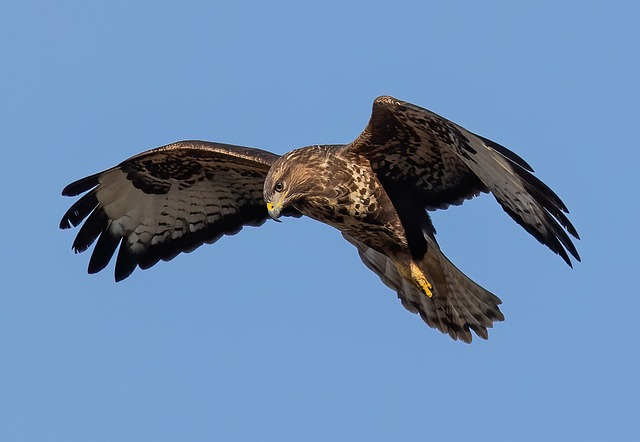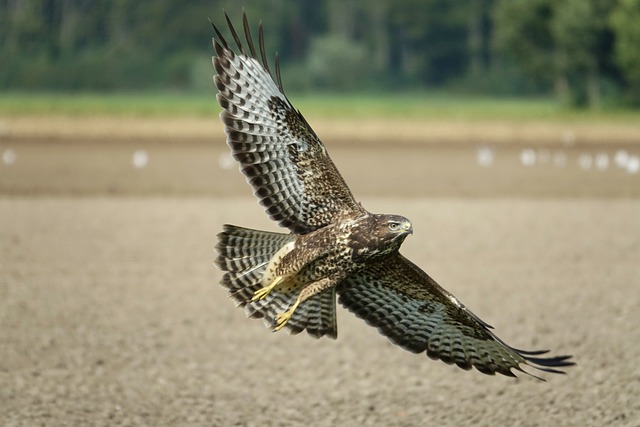The common buzzard (Buteo buteo) is a medium-to-large bird of prey which has a large range. It is a member of the genus Buteo in the family Accipitridae.
The species lives in most of Europe and extends its breeding range across much of the Palearctic as far as northwestern China (Tian Shan), far western Siberia and northwestern Mongolia.
Here are facts about Common Buzzards
Facts
Scientific Name: The common buzzard is scientifically known as Buteo buteo.
Size: They are medium-sized raptors, with a wingspan typically ranging from 38 to 50 inches (96 to 126 centimeters).
Plumage Variation: Common buzzards can exhibit a wide range of plumage variations, with colors ranging from light to dark.
Range: They have a widespread distribution across Europe, Asia, and parts of North Africa.
Habitat: Common buzzards are adaptable and can be found in a variety of habitats, including woodlands, grasslands, moors, and farmland.
Feeding Habits: They are opportunistic hunters and primarily feed on small mammals, birds, insects, and carrion.

Scavengers: Common buzzards often feed on roadkill and other carrion, making them an important part of the ecosystem.
Flight Pattern: They have a distinctive slow and soaring flight pattern, often using thermal updrafts to gain altitude.
Migratory Behavior: While some populations are migratory, many common buzzards are sedentary and stay in their territories year-round.
Hunting Strategy: Buzzards typically hunt by perching on a high vantage point and scanning for prey below.
Vocalizations: They produce a variety of calls, including mewing, screeching, and whistling sounds, often used during courtship and territory defense.
Monogamous Pairs: Common buzzards often form monogamous pairs that remain together for several breeding seasons.
Nesting Sites: They build nests in trees, cliffs, or on the ground, using sticks, twigs, and grasses.
Eggs: A typical clutch contains 2 to 4 eggs, which are incubated by the female for about a month.
Chick Development: The chicks fledge and become independent after 6 to 8 weeks.
Territories: They defend territories during the breeding season, and disputes between neighboring pairs can lead to aerial displays and conflicts.
Populations: Common buzzards are one of the most numerous and widespread raptor species in Europe.
Conservation Status: They are classified as a species of “Least Concern” by the International Union for Conservation of Nature (IUCN).
Physical Appearance: Common buzzards have broad wings, a short neck, and a relatively long tail.
Camouflage: Their plumage can vary from light to dark brown, with streaks and bars that provide camouflage while perched.
Varied Diet: Their diet includes mammals like voles and rabbits, as well as birds, reptiles, and even earthworms.
Territorial Birds: During the breeding season, common buzzards become territorial and defend their hunting grounds.
Aggressive Displays: They engage in territorial displays, including aerial acrobatics and loud calls, to deter intruders.
Nocturnal Hunting: While primarily diurnal, they may also hunt at dawn and dusk.
Eyesight: Common buzzards have exceptional eyesight, allowing them to spot prey from high in the sky.
Widespread Distribution: They can be found across a range of temperate habitats, from open countryside to forests.
Courtship Flights: During courtship, pairs engage in aerial displays, spiraling together and locking talons before separating.
Longevity: Common buzzards can live for up to 10 to 15 years in the wild.
Wing Feathers: The primary feathers of their wings have black tips, and their tail feathers are typically barred.
Hunting Strategy: They use their sharp talons to capture and kill prey.
Habitat Variation: The type of habitat a common buzzard prefers can vary by region, from coastal areas to mountains.

Population Fluctuations: The abundance of common buzzards can fluctuate based on factors such as food availability and weather conditions.
Diurnal Raptors: Common buzzards are part of a group of raptors known as “diurnal” birds of prey, meaning they are active during the day.
Large Range of Prey: Their diet can include everything from small mammals to insects, depending on availability.
Conservation Success: The population of common buzzards in Europe has recovered in recent decades, thanks in part to legal protection.
Territorial Calls: They use vocalizations, including a distinctive mewing call, to communicate with other buzzards in their territory.
Nest Reuse: Common buzzards often reuse the same nest in consecutive breeding seasons, adding new materials each year.
Reproduction Rates: They tend to have higher reproductive rates in areas with abundant food.
Caching Food: Buzzards may cache extra food items by wedging them in tree forks or hiding them under leaves.
High Mortality: Many young buzzards do not survive their first year due to predation, food shortages, and accidents.
Feeding Etiquette: They may share a meal with other buzzards if there’s enough food to go around.
Vision Adaptations: Their eyes are adapted to detect the ultraviolet glow of urine trails left by rodents, making it easier to locate prey.
Population Density: The density of common buzzard populations can vary widely depending on the region and habitat.
Cultural Significance: In some cultures, common buzzards have been associated with symbolism and folklore.
Name Origins: The name “buzzard” likely derives from the Old French word “busard,” which means hawk or falcon.
Raptors of Prey: They are part of the family Accipitridae, which includes eagles, hawks, and other raptors.
Hunting Techniques: Buzzards use a combination of soaring and gliding to conserve energy while searching for prey.
Plumage Adaptations: Their plumage helps them blend into their surroundings while perched, making them less visible to potential prey.
Young Buzzards: Juvenile buzzards often have more mottled plumage compared to adults.
Population Monitoring: Conservationists and researchers monitor common buzzard populations to assess their health and response to environmental changes.
Common buzzards are fascinating raptors with diverse hunting habits and adaptations that make them successful predators in a variety of habitats. They are an important part of many ecosystems and hold cultural significance in different parts of the world.
